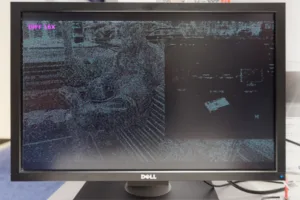The display shows the pixels that have been changed by 3X DSC compression, magnified by 16. At 1X the display was almost blank!We spent some time with the VESA DisplayPort group and there were a couple of interesting demonstrations. First, we looked at a prototype DisplayPort 1.3 cable running a single cable to support the Dell 5120 x 2880 (14.7 megapixels) display. DisplayPort V1.2 (and therefore the Dell monitor) needs two cables to support that resolution which has 77% more pixels than UltraHD displays.
One of the most interesting demonstrations was of the DisplayStream compression (DSC) standard. DisplayStream uses a small amount of silicon (a “few 100K gates”) to lightly (up to 3X or so) compress graphics in a way that has been designed to be visually lossless. We were intrigued by a demo arranged by Hardent of Montreal which was showing an interesting difference map which showed, amplified by 16, the differences between a compressed and uncompressed image (with 3X compression). We had a close look at a compressed image and really couldn’t see the difference between that and an uncompressed one.
Staff on the booth from Parade Technologies were also pleased that the way that the “Direct Connect Source Spec” part of the HDMI standard has allowed the development of direct DP to HDMI 1.2 cables. In the past, these had to be made with adaptors. Using an adaptor meant more HDMI parts (and licence costs) and was, apparently, resisted by HDMI, but the terms of the standard allow it, so they have been unable to stop the move. We heard that the spec will also allow direct USB Type C to HDMI cables (as HDMI is also developing an “alternate mode” for USB-C)
Parade has also developed eDP Tcons that support the panel self refresh (PSR) technology.
Display Daily Comment
It looks as though DSC will be widely adopted as it forms an important part of SuperMHL. I was impressed with the lack of artefacts and the combination of DSC with PSR could reduce the bandwidth between devices and displays considerably, reducing the power requirements and helping enable wireless solutions.
We also heard that Silicon Image is not pleased with the exploitation of the Direct Connect Source Spec as it reduces the firm’s licensing income, when compared to stand-alone converters. (BR)

